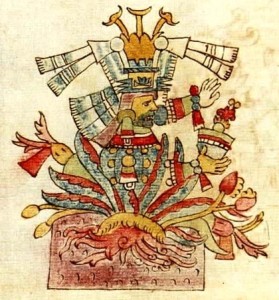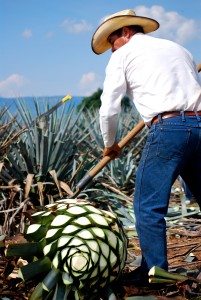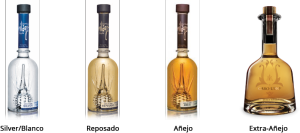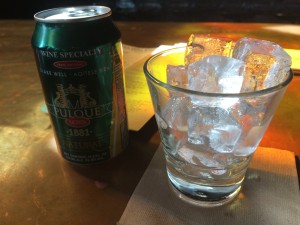By: Morgan Rease
Love it or hate it, tequila is without a doubt Mexico’s most recognized alcoholic beverage. However, its repuation is not always one of prestige. Too often tequila is associated with rough nights and rougher mornings, the worm, and painfully sweet “margaritas”. Tequila’s name has been dragged through the mud in the past, but it’s popularity is growing. Tequila’s identity is becoming one of distinction, yet people’s knowledge of tequila’s history and production is relatively minimal. How much do you know about it?
Para todo mal, mezcal.
Para todo bien, tambien.
-Oaxacan Proverb
The Product
Tequila is just one variety within a greater class of spirits known as Mezcals. Mezcal is a distilled liquor produced by fermenting sugars extracted from the maguey (muh-gay) plant, also known as the century plant or agave. What distinguishes tequila from other mezcals is the variety of agave used as well as the production region.
Mezcal may only be called tequila if the agave used is Agave tequilana weber azul, aka the blue agave. Like sparkling wines such as Champagne (from the Champagne region in France), tequila production is protected by regional appellations, which are regulated by the Consejo Regulador del Tequila (CRT).[3] Tequila can only be produced in the Jalisco, Nayarit, Tamaulipas, Michoacán and Guanajuato regions of Mexico.
A Brief History:

Mayahuel, an Aztec goddess
Although distillation only became possible after the Spanish conquest of Mexico, the maguey has been an integral part of Mexican culture for millenia. Native cultures of Mexico have used the maguey for food, rope, fabric, medicine, and drink for thousands of years.[4] Mayahuel, an Aztec goddess, is associated with the maguey, fertility, and another alcoholic beverage called pulque, which we’ll discuss later
Mezcal was brought to international attention relatively recently during the 1893 World’s Fair in Chicago, Illinois, where it debuted alongside several other still popluar products: Wrigley’s Juicy Fruit gum, Cracker Jacks, and Aunt Jemima pancake mix.[1] Pabst Beer won its infamous ‘Blue Ribbon’ during the fair. Mezcal was also very well received, winning a total of seven awards.[2]

Gif courtesy of Imgur.com
The Process
 To produce mezcal, the maguey plant must first mature for 8-10 years.[5] Once mature, the outer leaves are removed by a jimador (a person who harvests maguey) with a specialized tool called a coa.[4] What is left of the plant is referred to as the piña.[5] The piñas will then be split open and cooked to convert the starches into fermentable sugars. Traditionally, cooking is done in stone ovens called hornos, but modern production employs the use of large steam ovens and autoclaves. Once cooked the piñas will be mashed and the sugar rich liquid will be collected and tranferrered to a fermentation vessel. Mezcals undergo spontaneous fermentations by yeast and bacteria, most of which will picked up by the crushing and fermentation equipment, though some producers do add yeast.[6, 7] The fermentation stage is where the aromatic compounds of the final product are produced, so where your mezcal is fermented matters![7] Mezcals must then be distilled twice, the first distillate is divided into three parts based on when it comes out of the still: the cabeza (head), corazón (heart), and cola (tail). Due to high levels of impurities in the cabeza and cola, only the corazón will move to the second distillation.[4]
To produce mezcal, the maguey plant must first mature for 8-10 years.[5] Once mature, the outer leaves are removed by a jimador (a person who harvests maguey) with a specialized tool called a coa.[4] What is left of the plant is referred to as the piña.[5] The piñas will then be split open and cooked to convert the starches into fermentable sugars. Traditionally, cooking is done in stone ovens called hornos, but modern production employs the use of large steam ovens and autoclaves. Once cooked the piñas will be mashed and the sugar rich liquid will be collected and tranferrered to a fermentation vessel. Mezcals undergo spontaneous fermentations by yeast and bacteria, most of which will picked up by the crushing and fermentation equipment, though some producers do add yeast.[6, 7] The fermentation stage is where the aromatic compounds of the final product are produced, so where your mezcal is fermented matters![7] Mezcals must then be distilled twice, the first distillate is divided into three parts based on when it comes out of the still: the cabeza (head), corazón (heart), and cola (tail). Due to high levels of impurities in the cabeza and cola, only the corazón will move to the second distillation.[4]
Varieties:
Distillation can be the last step in processing mezcal, however, some varieties will go on to be aged. For tequilas, the unaged second distillate is known as tequila blanco. If aged in oak barrels for 2-12 months, it is known as tequila reposado If aged in barrels for at least 12 months, it becomes tequila añejo, and with 3+ years of aging it becomes extra añejo (yes, that’s the actual term). . Rather than aging in barrels, producers can add coloring and additives to mellow the flavor in a way similar to aging to produce tequila oro. If coloring and additives are used, the tequila is referred to as an abocado.[4]
Quick Reference[9]:
| Classification | Alternative Names | Aging Period |
| Tequila Blanco | Plata, Silver | No aging |
| Tequila Reposado | Rested, Aged | Aged 2-12 months |
| Tequila Añejo | Extra Aged | Aged 1-3 years |
| Tequila Extra Añejo | Ultra Aged | Aged 3+ years |
| Tequila Oro | Gold, Joven | Coloring and flavors added to mimic aging |

Various types of tequila
Pulque:
Earlier I said that maguey had been used in beverages for thousands of years but distillation was only possible after the technology was introduced by Spaniards…puzzling. Well as recently as 1901, 87% of the alcohol consumed in Mexico was pulque.[4] Pulque is a beverage produced by hollowing the center of the maguey, which will then collect aguamiel (translates as honey-water, aka sap). The sap will be collected and transferred to pulquerias (a place that produces pulque, just as a brewery produces beer) where it undergoes a natural fermentation from the yeasts found on the leaves of the maguey.[5] It is opaque and white in color, has the consistency reminiscent of mucous, and smells strongly of yeast.[10]

Gif courtesy of Imgur.com
I managed to find some in San Francisco’s Mission district and gave it a try.To my surprise, it came in a can and tasted like somewhat like white wine that had been watered down. I also tried one that was flavored with pineapple and coconut, which tasted like a piña collada. Both were much better than I had been preparing myself for based on the less than stellar description, but I think I still prefer a nice margarita.

I took this picture
Myths, Tips, & More:
Despite the similar name, mezcal does not conatin any mezcaline (a psychadelic drug).
Although bottles are sometimes depicted as containing a worm (which is actually a caterpillar), this practice is not traditional for either mezcal or tequila production. The inclusion of the worm is for marketing purposes only. However, they are safe to eat should you come across one and are feeling particularly daring.[5]
The U.S. consumes twice as much tequila as Mexico.[4]
99% of agave grown for tequila are vegetative clones.[4]
An unintentional effect of harvesting agave before they can flower is that bats, agave’s natural pollinator, are not able to stop at flowering plants to rest and drink the nectar. The result? Less genetic diversity and fewer bats.[4] ¡Que horrible!
References
- Mohr, B. Opening the Vaults: Wonders of the 1893 World’s Fair. 2014 [cited 2015 October 10th, 2015].
- Awards, U.S.W.s.C.C.C.o., World’s Columbian Exposition, Chicago, Ill., 1893. 1901: U.S. Government Printing Office.
- Jacinto, R. How Is Tequila Made. 2010 [cited 2015 October 11th, 2015].
- Ana Guadalupe Valenzuela Zapata, G.N., Tequila: A Natural and Cultural History. 2004: University of Arizona Press.
- Chadwick, I. Tequila. [website] 2011 May 2011 [cited 2015 October 10, 2015].
- Escalante-Minakata, P., et al., Identification of yeast and bacteria involved in the mezcal fermentation of Agave salmiana. Letters in Applied Microbiology, 2008. 46(6): p. 626-630.
- Lappe-Oliveras, P., et al., Yeasts associated with the production of Mexican alcoholic nondistilled and distilled Agave beverages. FEMS Yeast Research, 2008. 8(7): p. 1037-1052.
- Lachance, M.A., YEAST COMMUNITIES IN A NATURAL TEQUILA FERMENTATION. Antonie Van Leeuwenhoek International Journal of General and Molecular Microbiology, 1995. 68(2): p. 151-160.
- Roldán, C.T., NORMA OFICIAL MEXICANA NOM-006-SCFI-2012, BEBIDAS ALCOHOLICAS-TEQUILA-ESPECIFICACIONES, I.C.y.P.d.C. Comité Consultivo Nacional de Normalización de Seguridad al Usuario, Editor. 2012, Comité Consultivo Nacional de Normalización de Seguridad al Usuario, Información Comercial y Prácticas de Comercio: el Diario Oficial de la Federación.
- Cohen, B. Mexico’s ancient drink makes a comeback. 2014.






Leave a Reply